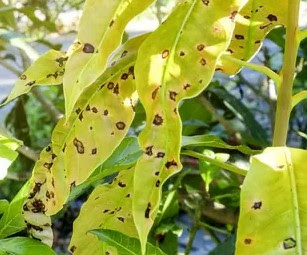The symptoms of a phoma blight infection are visible only on older leaves. When the fungus first attacks the leaves, symptoms show as small, discolored yellowish and brownish spots. Affected leaves display angular, yellow to brown irregular lesions scattered over the entire lamina.
As the fungal spores continue to develop, the spotting grows in size and area, with the coloration changing to a rusty brown and the centers can take on a grayish color. As the lesions enlarge their colour changes from brown to cinnamon.
Phoma blight spreads rapidly, and any health part of a plant that is touching infected soil is at risk of succumbing.
The symptoms are cause by the fungus Peyronellaea glomerata, formally known as phoma glomerata, thereby the common name of the disease. Phoma glomerata was originally described as a Coniothyrium by Corda. Woolenweber and Hochapfel transferred it to the genus Phoma and added the description for dictyospores. The species of sect. Peyronellaea are characterized by the production of conspicuous multicellular chlamydospores.
Infections by this fungus are most common in wet and cool conditions. It survives in soil and in the old plant debris that is under your plantings.
Phoma blight of mango
Mango is one of the popular fruits in the world due to its attractive color, delicious taste and excellent nutritional properties. Known for its sweet fragrance and flavor, the mango has delighted the senses for more than 4000 years. A celebrated fruit, mango, now produced in most of the tropical parts of the globe.
Tuesday, February 1, 2022
Popular Posts
-
History and Origin of Mango The mango has been known in India since very early times. It is referred to in Sanskrit literature as Amra and h...
-
This tropical fruit is high in vitamin C. Mango fruits contain 10-20 percent sugar and are important source of vitamin A. They have a rich,...
-
Uses of Mango and Nutritional Composition Mango is commonly eaten fresh and depending upon the cultivar may be consumed at an immature (unri...
-
The mango is believed to have been discovered as long as five to six thousand years in eastern India, Thailand, Myanmar, the Andaman Islands...





